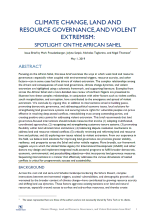/ library resources
Showing items 1 through 9 of 15.Few regions present bigger development challenges than the African drylands – home to nearly 300 million people, and the vast majority of Africa’s poor. Food security and rural welfare in these areas are limited by a range of factors, biophysical, socio-economic and policy-related.
ICARDA has long-standing outreach programs in North Africa, the Nile Valley, and the Red Sea region (Fig 2). In its current strategic plan, the Center will extend its work to the drylands of Sub-Saharan Africa.
The support plan for the Sahel is a regional approach to collectively address the root causes of disruptions such as poverty, migration and youth unemployment, climate change, insecurity, governance and institutional issues in the region.
‘Over the past three decades hundreds of thousands of farmers in Burkina Faso and Niger, on the fringes of the Sahara Desert, have transformed large swathes of the region’s arid landscape into productive agricultural land, improving food security for about three million people.
Poverty in the Near East and North Africa region (NENA) is mainly a rural phenomenon. Almost half (48%) the area’s population lives in rural areas.
Population growth leads to growing land scarcity and landlessness in poor agrarian economies. Many of these also face severe climate risks that may increase in the future.
In Africa, where most agriculture is rainfed, crop growth is limited by water availability. Rainfall variability during a growing season generally translates into variability in crop production.
Tetra Tech’s land tenure and property rights experts examine how weak land and resource governance can fuel drivers of violent extremism.
Нумерация страниц
Land Library Search
Through our robust search engine, you can search for any item of the over 73,000 highly curated resources in the Land Library.
If you would like to find an overview of what is possible, feel free to peruse the Search Guide.







